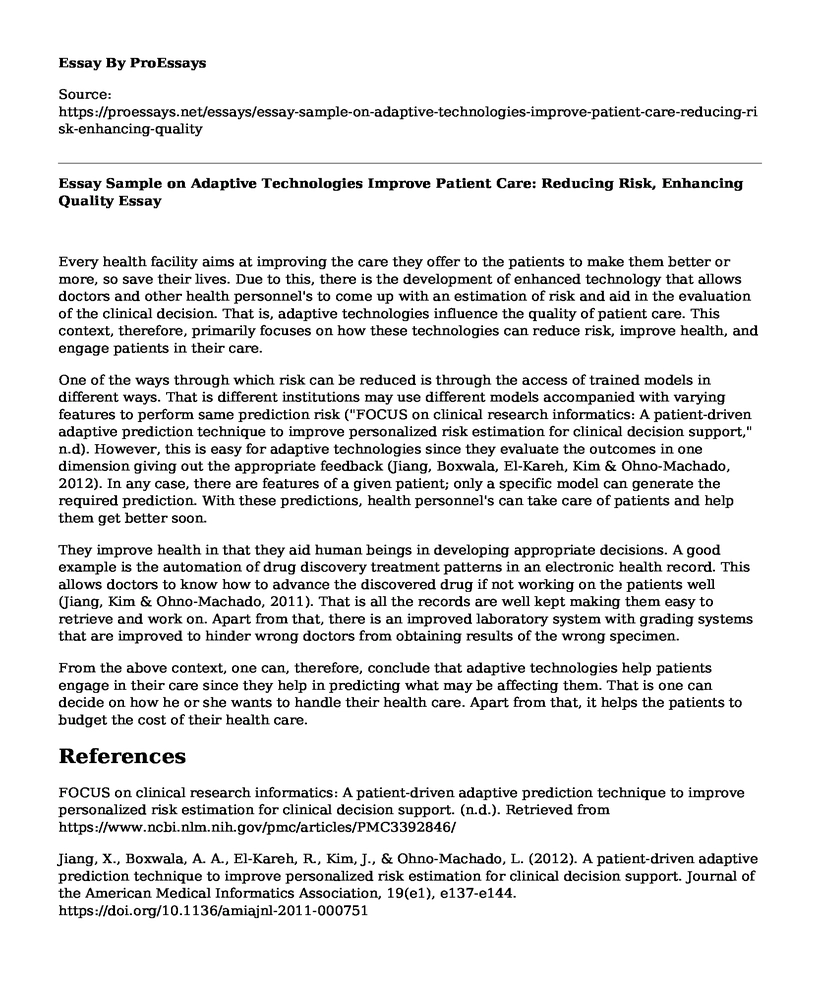Every health facility aims at improving the care they offer to the patients to make them better or more, so save their lives. Due to this, there is the development of enhanced technology that allows doctors and other health personnel's to come up with an estimation of risk and aid in the evaluation of the clinical decision. That is, adaptive technologies influence the quality of patient care. This context, therefore, primarily focuses on how these technologies can reduce risk, improve health, and engage patients in their care.
One of the ways through which risk can be reduced is through the access of trained models in different ways. That is different institutions may use different models accompanied with varying features to perform same prediction risk ("FOCUS on clinical research informatics: A patient-driven adaptive prediction technique to improve personalized risk estimation for clinical decision support," n.d). However, this is easy for adaptive technologies since they evaluate the outcomes in one dimension giving out the appropriate feedback (Jiang, Boxwala, El-Kareh, Kim & Ohno-Machado, 2012). In any case, there are features of a given patient; only a specific model can generate the required prediction. With these predictions, health personnel's can take care of patients and help them get better soon.
They improve health in that they aid human beings in developing appropriate decisions. A good example is the automation of drug discovery treatment patterns in an electronic health record. This allows doctors to know how to advance the discovered drug if not working on the patients well (Jiang, Kim & Ohno-Machado, 2011). That is all the records are well kept making them easy to retrieve and work on. Apart from that, there is an improved laboratory system with grading systems that are improved to hinder wrong doctors from obtaining results of the wrong specimen.
From the above context, one can, therefore, conclude that adaptive technologies help patients engage in their care since they help in predicting what may be affecting them. That is one can decide on how he or she wants to handle their health care. Apart from that, it helps the patients to budget the cost of their health care.
References
FOCUS on clinical research informatics: A patient-driven adaptive prediction technique to improve personalized risk estimation for clinical decision support. (n.d.). Retrieved from https://www.ncbi.nlm.nih.gov/pmc/articles/PMC3392846/
Jiang, X., Boxwala, A. A., El-Kareh, R., Kim, J., & Ohno-Machado, L. (2012). A patient-driven adaptive prediction technique to improve personalized risk estimation for clinical decision support. Journal of the American Medical Informatics Association, 19(e1), e137-e144. https://doi.org/10.1136/amiajnl-2011-000751
Jiang, X., Osl, M., Kim, J., & Ohno-Machado, L. (2011). Calibrating predictive model estimates to support personalized medicine. Journal of the American Medical Informatics Association, 19(2), 263-274. https://doi.org/10.1136/amiajnl-2011-000291
Cite this page
Essay Sample on Adaptive Technologies Improve Patient Care: Reducing Risk, Enhancing Quality. (2023, Feb 09). Retrieved from https://proessays.net/essays/essay-sample-on-adaptive-technologies-improve-patient-care-reducing-risk-enhancing-quality
If you are the original author of this essay and no longer wish to have it published on the ProEssays website, please click below to request its removal:
- Experience of Adult Patients with Tracheotomy in Situ
- Paper Example on Antibiotic Resistance
- Social Determinants of Health, Poverty and Christian Views Essay
- Healthcare Operation Management: Essay Sample
- iOmniscient: AI Technologies for Hosting Industries - Essay Sample
- MERS-CoV Infection: 6 New Cases Reported in Saudi Arabia - Essay Sample
- Essay Sample on Advanced Nurse Practice: Personal & Professional Development







